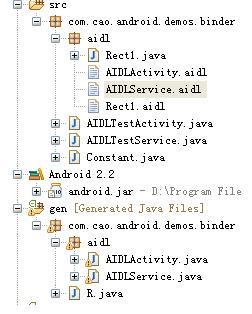aidl详解:同一APK内,不同apk间的activty与service通信
来源:互联网 发布:17173lol数据库 编辑:程序博客网 时间:2024/05/22 00:08
1.什么是aidl:aidl是 Android Interface definition language的缩写,一看就明白,它是一种android内部进程通信接口的描述语言,通过它我们可以定义进程间的通信接口
icp:interprocess communication :内部进程通信
2.既然aidl可以定义并实现进程通信,那么我们怎么使用它呢?文档/android-sdk/docs/guide/developing/tools/aidl.html中对步骤作了详细描述:
--1.Create your .aidl file - This file defines an interface (YourInterface.aidl) that defines the methods and fields available to a client.
创建你的aidl文件,我在后面给出了一个例子,它的aidl文件定义如下:写法跟java代码类似,但是这里有一点值得注意的就是它可以引用其它aidl文件中定义的接口,但是不能够引用你的java类文件中定义的接口
- package com.cao.android.demos.binder.aidl;
- import com.cao.android.demos.binder.aidl.AIDLActivity;
- interface AIDLService {
- void registerTestCall(AIDLActivity cb);
- void invokCallBack();
- }
--2.Add the .aidl file to your makefile - (the ADT Plugin for Eclipse manages this for you). Android includes the compiler, called AIDL, in the tools/ directory.
编译你的aidl文件,这个只要是在eclipse中开发,你的adt插件会像资源文件一样把aidl文件编译成java代码生成在gen文件夹下,不用手动去编译:编译生成AIDLService.java如我例子中代码

--3.Implement your interface methods - The AIDL compiler creates an interface in the Java programming language from your AIDL interface. This interface has an inner abstract class named Stub that inherits the interface (and implements a few additional methods necessary for the IPC call). You must create a class that extends YourInterface.Stub and implements the methods you declared in your .aidl file.
实现你定义aidl接口中的内部抽象类Stub,public static abstract class Stub extends android.os.Binder implements com.cao.android.demos.binder.aidl.AIDLService
Stub类继承了Binder,并继承我们在aidl文件中定义的接口,我们需要实现接口方法,下面是我在例子中实现的Stub类:
- private final AIDLService.Stub mBinder = new AIDLService.Stub() {
- @Override
- public void invokCallBack() throws RemoteException {
- Log("AIDLService.invokCallBack");
- Rect1 rect = new Rect1();
- rect.bottom=-1;
- rect.left=-1;
- rect.right=1;
- rect.top=1;
- callback.performAction(rect);
- }
- @Override
- public void registerTestCall(AIDLActivity cb) throws RemoteException {
- Log("AIDLService.registerTestCall");
- callback = cb;
- }
- };
Stub翻译成中文是存根的意思,注意Stub对象是在被调用端进程,也就是服务端进程,至此,服务端aidl服务端得编码完成了。
--4.Expose your interface to clients - If you're writing a service, you should extend Service and override Service.onBind(Intent) to return an instance of your class that implements your interface.
第四步告诉你怎么在客户端如何调用服务端得aidl描述的接口对象,doc只告诉我们需要实现Service.onBind(Intent)方法,该方法会返回一个IBinder对象到客户端,绑定服务时不是需要一个ServiceConnection对象么,在没有了解aidl用法前一直不知道它是什么作用,其实他就是用来在客户端绑定service时接收service返回的IBinder对象的:
- AIDLService mService;
- private ServiceConnection mConnection = new ServiceConnection() {
- public void onServiceConnected(ComponentName className, IBinder service) {
- Log("connect service");
- mService = AIDLService.Stub.asInterface(service);
- try {
- mService.registerTestCall(mCallback);
- } catch (RemoteException e) {
- }
- }
- public void onServiceDisconnected(ComponentName className) {
- Log("disconnect service");
- mService = null;
- }
- };
mService就是AIDLService对象,具体可以看我后面提供的示例代码,需要注意在客户端需要存一个服务端实现了的aidl接口描述文件,但是客户端只是使用该aidl接口,不需要实现它的Stub类,获取服务端得aidl对象后mService = AIDLService.Stub.asInterface(service);,就可以在客户端使用它了,对mService对象方法的调用不是在客户端执行,而是在服务端执行。
4.aidl中使用java类,需要实现Parcelable接口,并且在定义类相同包下面对类进行声明:
上面我定义了Rect1类
之后你就可以在aidl接口中对该类进行使用了
package com.cao.android.demos.binder.aidl;
import com.cao.android.demos.binder.aidl.Rect1;
interface AIDLActivity {
void performAction(in Rect1 rect);
}
注意in/out的说明,我这里使用了in表示输入参数,out没有试过,为什么使用in/out暂时没有做深入研究。
5.aidl使用完整示例,为了清除说明aidl使用,我这里写了一个例子,例子参考了博客:
http://blog.csdn.net/saintswordsman/archive/2010/01/04/5130947.aspx
作出说明
例子实现了一个AIDLTestActivity,AIDLTestActivity通过bindservice绑定一个服务AIDLTestService,通过并获取AIDLTestActivity的一个aidl对象AIDLService,该对象提供两个方法,一个是registerTestCall注册一个aidl对象,通过该方法,AIDLTestActivity把本身实现的一个aidl对象AIDLActivity传到AIDLTestService,在AIDLTestService通过操作AIDLActivity这个aidl远端对象代理,使AIDLTestActivity弹出一个toast,完整例子见我上传的资源:
http://download.csdn.net/detail/tiananma0607/9248037两个apk之间数据通信(AIDL通信)
研究过framwork的都知道,有一种通信叫跨进程通信---binder通信。每个模块都离不开binder。
那么两个apk直接通信用什么方法呢?可以用跨进程的服务和AIDL来实现。
前段时间,我想实现两个一个apk调用另一个apk的方法时,在网上搜也没搜到完整的例子。APIDemos里面的例子也不完整。
所就整理出完整的例子供一起学习。
服务端:
布局:
Activity1:
AIDL接口:
实现AIDL接口:
客户端:
布局:
Activity :
AIDL接口(和服务端的接口一模一样,包名也必须相同,不论这个服务接口定义在哪里,只要包名和类名一样,都指的是同一个):
网上有在写客户端的时候,把服务端的gen目录下的 包和文件原封不动拷贝到客户端。其实和在客户端创建一模一样的AIDL接口是一样的道理。
以上内容网上转载,实际例程在文章第一部分例程基础上修改
测试工程详见地址,http://download.csdn.net/detail/tiananma0607/9248057
- aidl详解:同一APK内,不同apk间的activty与service通信
- 两个在不同APK里的activity/service的通信
- 两个在不同APK里的activity/service的通信
- Activty与Service通信的所有情况(相同进程、不同进程)
- apk 与 native service 通信
- 关于service 与 activty 之间通信
- A.apk 使用aidl调用B.apk的Service的函数
- 两个apk之间数据通信。(AIDL通信)
- activty与service交互
- Service与AIDL详解
- Android组件---Service,AIDL,Service与Activity之间的通信
- 不同APK间的数据读取
- Android Studio 如何通过gradle实现同一套代码的开发不同特性的apk
- 如何用同一份代码生成不同包名的APK包
- Gradle-----通过Gradle实现同一套代码开发生成不同的apk
- Service详解(六):进程间通信-AIDL
- apk与apk 数据共享详解
- Service进程间通信AIDL
- Asp.net 学习之路---Http协议
- struts2中各个jar包作用
- tomcat 使用问题
- IOS页面转跳方法总结
- 如何一直显示tableview的滚动条(自定义方法)
- aidl详解:同一APK内,不同apk间的activty与service通信
- 《CoreData》系列(二)
- httpclient中文乱码问题
- MYSQL函数大全
- LeetCode 21:Merge Two Sorted Lists (Java)
- 【从零开始学NGUI 】 (十一)UIRoot
- 一文读懂卷积神经网络
- mybatise基于xml配置的实现增删改查的一个完整项目下载
- iOS 应用架构谈 本地持久化方案


